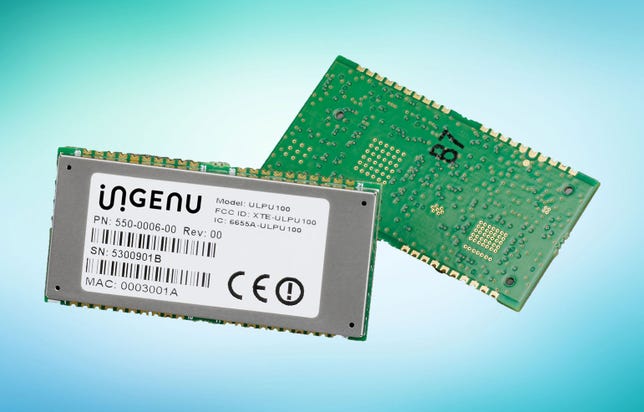
When you want to watch streaming videos in a taxi, you need a mobile network that can deliver the data as fast as possible. But a startup called Ingenu is betting that a lot of customers will pay for a slower network that’s cheaper to use.
Ingenu, until Wednesday known as On-Ramp Wireless, announced at the CTIA conference that it’s begun building a wireless network in the US that it’ll turn on starting in January in Phoenix, Arizona, and in Dallas, Texas. The network is for an expected multitude of devices in a technology that’s broadly called the Internet of Things.
In the still-forming Internet of Things era, countless other devices besides PCs and smartphones are connecting to the network, often talking directly to each other with no human involved. Among the devices are wearable gadgets, car antitheft monitors, traffic signals, and sensors used for business purposes like measuring building temperature and water-pipe pressure. A push-button pizza-ordering widget doesn’t need the same sort of network speeds and seamless transmission that you’d demand to view videos from, say, YouTube star Pewdiepie.
Ingenu may not be a brand that the average consumer will ever recognize, but if it succeeds, it’ll help power many services we’ll all use every day — insurance plans based on our actual driving, home devices that can send an alert when maintenance is needed, a more reliable electrical power delivery grid or health monitoring from afar. And no wonder Ingenu and others are interested: Analyst firm International Data Corp. expects spending on the Internet of Things to increase from $656 billion last year to $1.7 trillion in 2020.
With today’s fourth-generation (4G) mobile networks, phones can download data at something like 40 megabits per second and upload it at 20Mbps. That’s pretty good: YouTube videos even in high resolution need a only quarter of that download capacity. Ingenu won’t be near that rate, though it will be faster than the bad old days of dialup Internet access in the 1990s and than second-generation (2G) networks that are commonly used today for devices like sat-nav systems downloading traffic congestion data.
The Ingenu download speed is 624 kilobits per second, something like 10 times that of dialup Internet and half the speed of the earliest broadband networks, and upload speeds are 156Kbps. As with other mobile network technologies, Ingenu’s network slows down if the device it’s communicating with is on the move, dropping to 2Kbps.
Ingenu’s network is a lot faster than that of France-based competitor Sigfox, which has a head start on building its network in several European countries and which is starting to bring coverage to the United States. Sigfox can boast of a partnership with electronics giant Samsung for connected appliances.

 Enlarge Image
Enlarge ImageIngenu
Ingenu plans to charge customers to use its network, transferring a fixed amount of data per month. The company didn’t disclose its pricing, but expects it to be well below the premium rates that smartphone customers pay.
Why cheaper? In addition to being slower than cutting-edge mobile networks, Ingenu networks should be cheaper to construct and operate. For one thing, carriers don’t have to build nearly as many cell phone base stations to provide network coverage. A single tower can cover more than 300 square miles, meaning that it needs somewhere between a tenth or a thirtieth as many towers as mobile phone networks.
For another, Ingenu doesn’t have to pay for expensive government licenses to use precious radio spectrum. Instead, it uses the freely available 2.4GHz band most commonly associated with Wi-Fi networks.
For those building Ingenu network hardware into devices, modules will cost about what 2G and 3G phone network equipment costs, the company said. The network access fees “will be extremely competitive with the most aggressive cellular pricing” for machine-to-machine communications using phone networks. And because Ingenu uses publicly available radio spectrum, customers won’t have to replace their devices when the current 2G radio licensing deals expire and the government offers the radio spectrum for new uses.
Ingenu raised enough funding — more than $100 million so far — to bring coverage to more than 70 percent of the United States by 2017, it said. Also on Wednesday, it announced a partnership with MeterLinq to bring the network to Italy.
Updated at 6:05 a.m. September 11 to clarify the fraction of the country covered by the network.



